20 Best No Blossom Perennial Plants
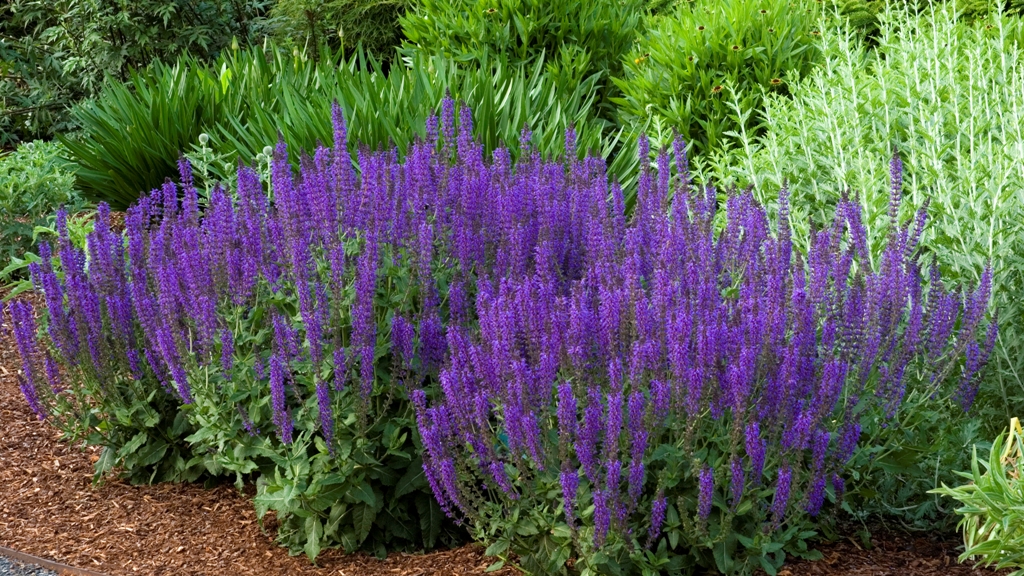
Perennials are the plants or flowers that have a lifespan of more than 2 years, and they return by blooming on their own. Their long and widespread roots allow them to do so by giving better access to nutrients, ensuring a longer lifespan.
These plants are available in various vibrant colors and shapes, which add to the beauty of your garden. Along with that, they are very easy to maintain and have the capacity to withstand harsh climates.
What should be considered before buying Perennials?
When to Plant?
This is something everyone should consider before planting a perennial. The best time to do so is during spring or the fall season. This is because the ground is moist during this time, and the air is also cooler, which makes it easier for the new roots to establish.
The Height of the Plant
When the plants are immature, they are of the same height, but at maturity, perennials are available at various heights that can even extend up to 60″ long. The location of the plant to be placed is important in deciding which perennial would suit your requirement the best.
Where Are You Going To Plant Them?
Some plants require complete direct sunlight to grow whilst some do well in the shade. Giving plants their preference for light not only keeps them happy but also makes them healthier and prettier.
Requirement of Soil
Like various other things, the preference of soil for different perennials varies. Some prefer fertile, well-drained soil. Take time to understand before buying if your plant requires wet soil or dry.
There are so many types of perennials to choose from; hence it can often be a dilemma to get the right one. Therefore, we have listed below 20 Best No Blossoms Perennial Plants to choose from and get your garden a beautiful addition.
1. Pink Muhly Grass (Muhlenbergia)
Hairawn Muhly is the most common name for Muhlenbergia Capillaris perennial plant, a native of North America, that grows about 30-90 cm tall and 60-90 cm wide. This beautiful, enticing plant, appearing like a huge fluff-ball or cotton candy (as some may say), is a double layer delight of colors.
The lower layer is bright green with a topping of pinkish-purple flowers. The green color eventually changes over time to a more copper shade as this is a warm-season grass. As the seasons change, the blossoming of flowers takes place. Being warm-season, it starts growing by summer and blooms completely by autumn. This extremely feathery and gorgeous plant was also chosen Plant of the Year in 2012 by the Garden Club of America.
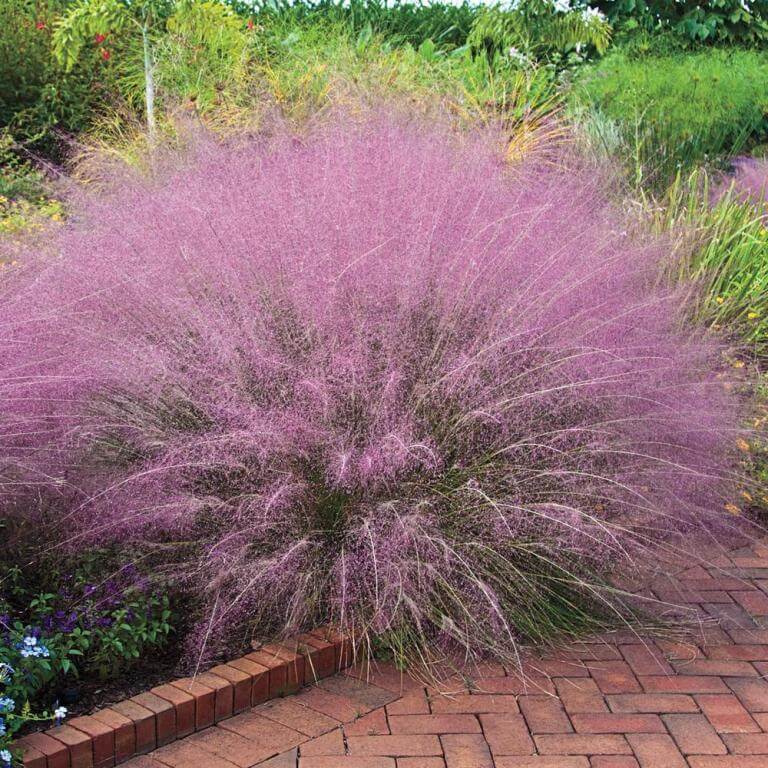
BUY NOW
Specifications
- Requires to be planted in full sun.
- Can grow up to 3 ft. tall with a width of 2.5 ft.
- Holds their color for a long time.
- Attracts beneficial insects like a ladybug.
- As potential as a fine fuel.
- Is disease resistant.
- Can withstand humidity, poor soil, heat but would appreciate extra water.
- Great for decoration of the garden.
- Has no blossoms.
- Has a clumping growth habit.
- Lets the scent of other flowers prevail.
Pros:
- Is very appealing to the eyes.
- Does not require high maintenance.
- Its beautiful colors keep the environment pleasant and positive.
- Has the capacity to resist diseases.
- Can grow in heat, humidity, and dry weather.
- Soil conditions need not be great.
- Has deer-resistant foliage, keeping itself damage-free.
- Requires watering only twice a week.
Cons:
- Cannot grow well without proper sunlight.
- Does not prefer regions with heavy rainfall.
- Has no scent.
FAQs
Q1. Is the plant shade tolerant?
No, the plant is not shade-tolerant as it requires full direct sunlight to grow properly.
Q2. Will the plant survive in clay soil?
Yes, it will.
Q3. What is the scientific name of this plant?
The scientific name of this plant is Muhlenbergia Capillaries.
We’ve listed everything you require to know before buying this beautiful plant. It is highly recommended and would surely change the whole look of your garden for the better!
2. Zebra Grass (Miscanthus)
Miscanthus, commonly known as Miscanthus, is a native of Japan. This plant dies in winter, but being perennial, it grows back in spring. The Zebra Grass can go up to 6 feet tall. These plants have beautiful arching leaves with cream-colored stripes across the width, creating an enticing amalgamation of golden and green color.
As time passes, the leaves keep developing the golden color, and finally, towards the end of fall, they turn beige. When the leaves fall off, the plant looks no less appealing because of its interesting skeleton left behind. This plant adopts a clumping habit for growing, which makes it perfectly suitable when grown in groups. The Zebra Grass is perfect for an area that offers direct or partially direct sunlight. Spacing the plants 36 to 48 inches apart is recommended.

BUY NOW
Specifications
- Requires to be planted in areas of direct or partially direct sunlight.
- Can grow up to 6 ft. tall.
- Golden color develops with time and eventually turns beige.
- Grows in Clay, Chalk, Sand, Loam soil.
- Can withstand drought for a short span.
- Has a clumping growth.
- Resistant to most pests and diseases.
- Is usually strong but might get damaged young leaves from chewing insects.
- Appreciates plenty of water for best growth.
Pros:
- Enhances the look of the garden with its attractive body.
- Is low maintenance.
- Its color duo is aesthetically pleasing.
- Is resistant to pests and diseases.
- Can survive in various kinds of soil.
- Mature plant has strong foliage.
Cons:
- If grown in a very shady area, the leaves may turn floppy.
- Cannot survive drought for long.
- Smaller leaves may get damaged by chewing insects.
FAQs
Q1. Does Zebra Grass need to be cut down when its leaves fall?
Yes, once the foliage dies, it needs to be cut off.
Q2. Can Zebra Grass be planted beside Pine Tree?
Yes, it can be as long as it has access to sunlight
3. Japanese Forest Grass (Hakonechloa)
Hakonechloa, commonly known as Japanese Forest Grass, is one of the few shades preferring grasses that also hold ornamental values. As the name suggests, it originates from the southeastern part of Japan. This plant can get up to 12 to 18 inches tall. The plant comes with a mixture of two to three colors, which gives out a very pleasant look to your surroundings.
Initially, the foliage is an eye-catching yellowish-gold color. This gold is only partially present at the start and develops into full gold later. When exposed to complete sunlight, it makes the foliage white except for gold. During fall, the Japanese Forest Grass looks more appealing as the foliage now turns into a bright reddish-pink color and soon turns brown before it dies.
This minimal care requiring plants should be grown in a shady area with moist soil. When the leaves turn brown as a result of being grown in the sun, they should be cut off to give out a more enticing look.
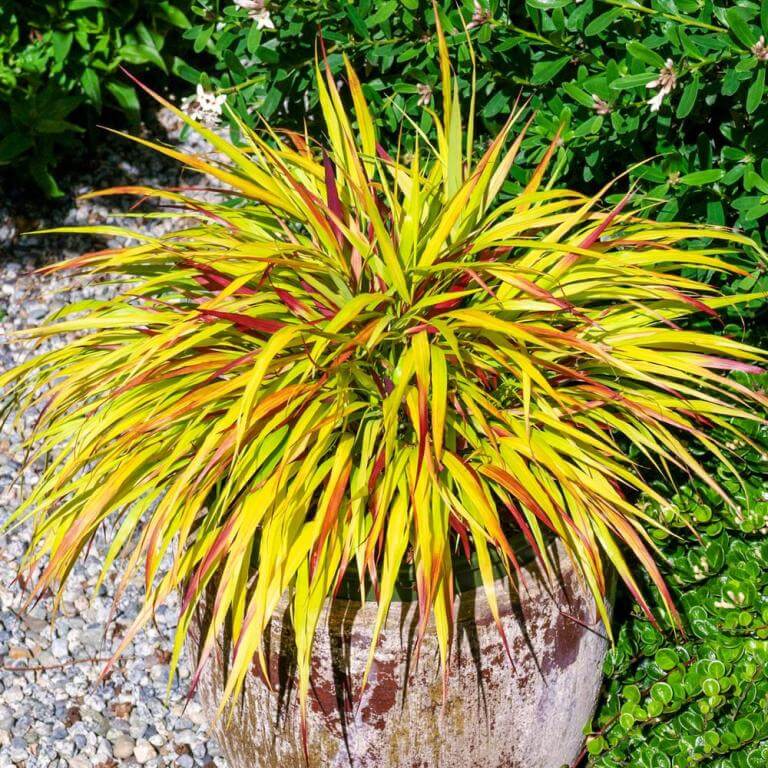
BUY NOW
Specifications
- Grows best in a completely shady area.
- Will survive in the part sun too.
- Mature Height 18 in. and Width 16 in.
- Adopts Mounded growth habit.
- Developing a golden color that turns pink and later brown.
- Grows in moist soil.
- Resistant to insects and diseases.
- Deer resistant foliage.
- Recommended spacing is 14-16 in. apart.
- Tips become dry when exposed to light.
Pros:
- Since it appreciates shade, it can be grown anywhere easily.
- Has various colors that will enhance the look of the surroundings.
- Does not attract insects and diseases.
- Its foliage is protected from deer.
- Is not high maintenance.
- Does not require constant watering.
Cons:
- Can’t survive well in open areas giving out direct sunlight.
- Can’t survive dry soil.
- Can’t survive in extreme conditions.
- Edges of the leaves fall off or become dry when in the sun.
FAQs
Q1. Do they divide easily?
Yes, once matured, they can be divided easily.
Q2. Will the plant survive in dry climate and drought?
No, the plant will die soon under such conditions.
4. Cherry Cola Red Bloom Plant
Cherry-Cola is a clump-forming coral bell which is widely known for its color and beautiful texture. The reddish-brown color of it is mesmerizing and gives a bold look to an average green garden. Their leaves are gently-lobed, forming a low mound.
The cherry cola has no major insect problem and grows perfectly in the sun. They can grow up to 16-18 inches tall and can spread across 12-16 inches. This easy to care plant does not require constant watering. The Cherry Cola is known for enticing, colorful butterflies that enhances the beauty of the garden to a different extent. It can also be considered as a gift plant due to its compact size and beauty.
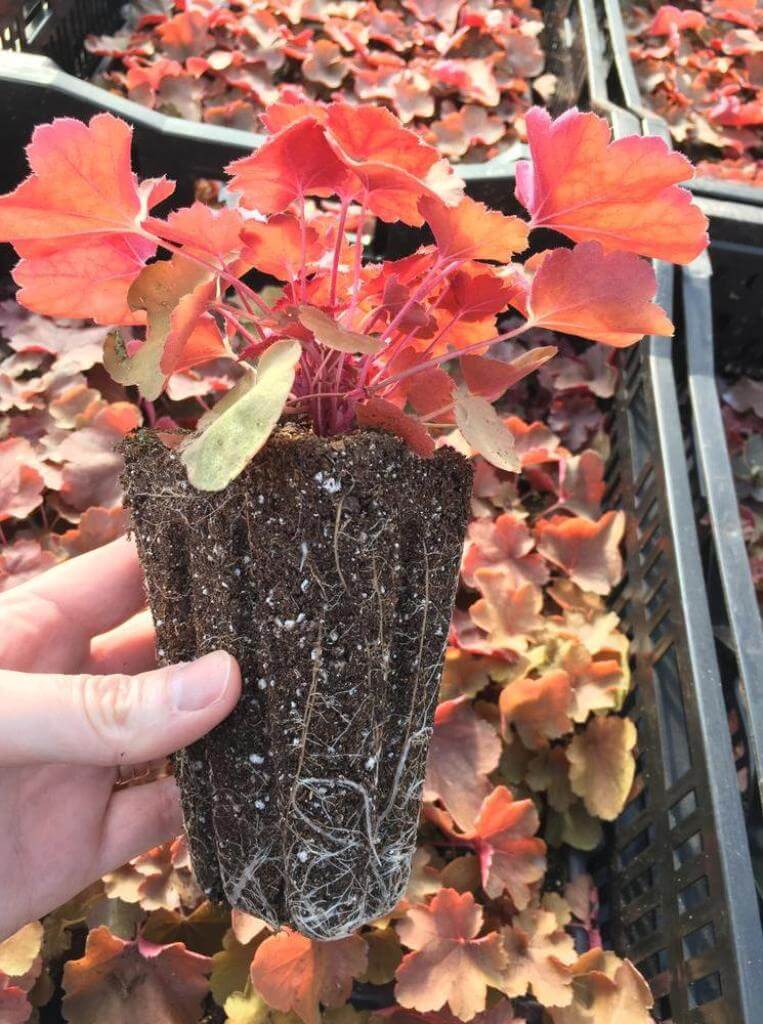
BUY NOW
Specifications
- Requires full sun or partial sun for best growth.
- Is of an unordinary color.
- Maximum mature height- 12 inches Width 14 inches.
- Deer Resistant.
- Insect Resistant.
- Rabbit Resistant.
- Has a mounding growth habit.
- Requires moderately well-drained soil.
Pros:
- Level of care is easy.
- Foliage is resistant to deer and rabbit.
- Usually, it is not harmed by insects.
- Gives out a very appealing look.
- Growth rate is fast.
- Has no foot traffic.
Cons:
- In extreme heat, it will require water constantly.
- In extreme winters, frost heaving of roots may occur.
- Might have bacterial leaf spots, weevils.
FAQs
Q1. What is the botanical name for Cherry Cola?
The botanical name is Heuchera.
Q2. Does this plant have a fragrance?
No, it is a non-fragrant plant.
5. Caramel Plant
These plants, too, are from the Heuchera family. They are bell-shaped with beautiful purple undersides and a creamy color above. They are bright in appearance and blend perfectly with any surroundings giving out an appealing look. As compared to other species, they have a higher tolerance for heat and humidity.
These Caramel plants are native to the southeastern United States. This semi-evergreen grows best in part shade with rich, well-drained soils. It attracts butterflies that add to its beauty.
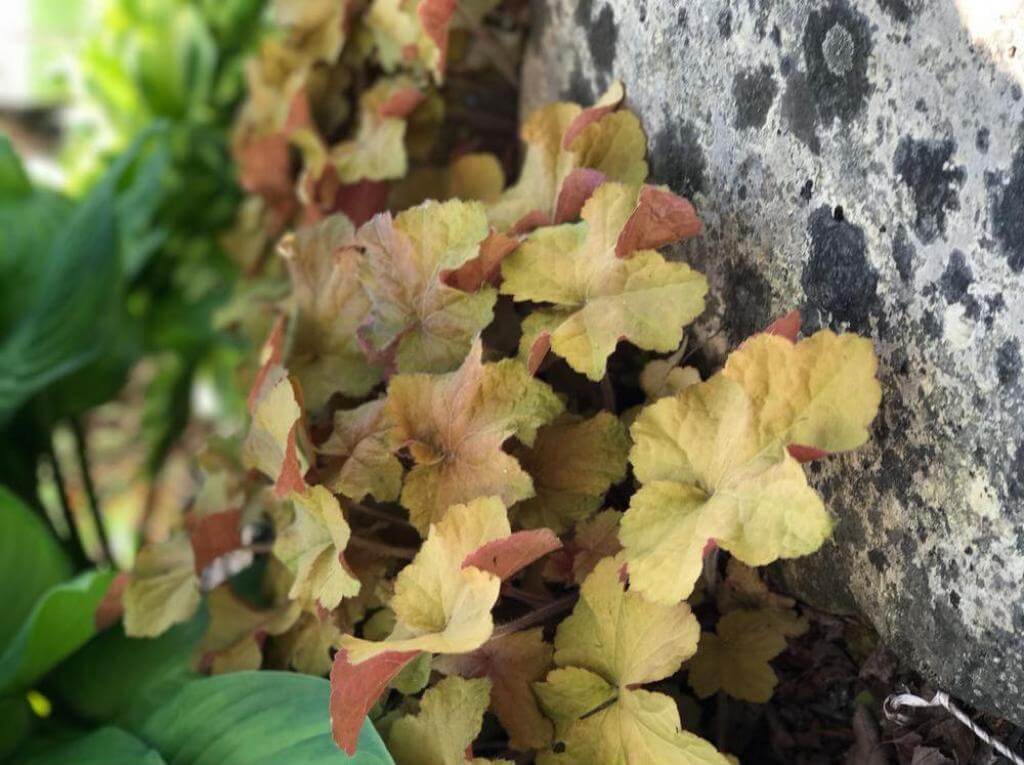
BUY NOW
Specifications
- Grows best in part shade but will tolerate direct sunlight.
- Has a beautiful color.
- Is low maintenance.
- Most suitable to be grown during fall.
- Does not have a fragrance.
- Recommended spacing is 12 inches apart.
- Adopts a mounded growth habit.
- Prefers moist soil.
- Average maturity Height- 10 inches, width- 12 inches.
Pros:
- Gives out an impressive look.
- Resistant to pests and diseases.
- Water needs are average.
- Attracts hummingbirds and butterflies.
- Is deer, rabbit, salt resistant.
- Easy to grow.
- Can survive in average quality soil.
Cons:
- May not survive in extreme climates.
- More the heat, more care regarding watering the plant becomes necessary.
- Does not contribute to the aroma of the garden.
FAQs
Q1. Can it survive in sand soil?
Yes, it can grow happily in sand soil.
Q2. What is the soil pH?
The soil pH is neutral.
6. Pot Golden Creeping Sedum
Sedums are usually of two types, tall and creeping. The tall ones have upright stems whilst creeping sedums have long, narrow stems that grow along the floor. The golden creeping sedum has bright and colorful foliage of various colors, in this case, golden.
The foliage is rounded and fleshy, and the plant covers up completely with golden flowers in summer. The plant loves direct sunlight of at least 5 hours daily. This beautiful plant is appealing to the eyes and radiates a positive aura. It gives a hint of bright color in a basic green garden. The plant has no fragrance, but its looks make up for it.
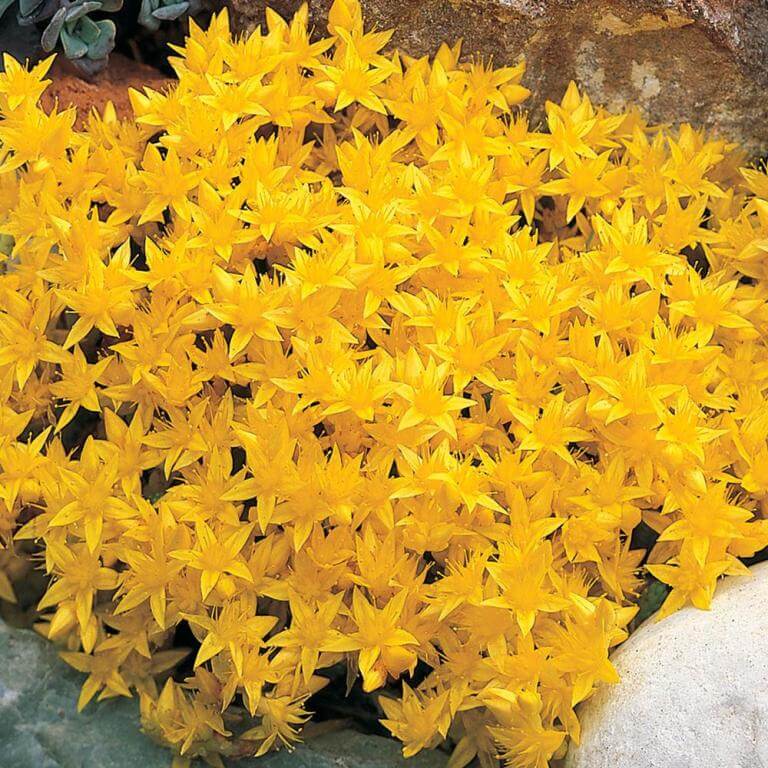
BUY NOW
Specifications
- Grows best in full sun.
- Requires water only once a week.
- Is easy to maintain.
- Recommended planting from spring to summer.
- Recommended spacing is 13 inches.
- Has a slow growth rate.
- Matures with height of 6 inches and width of 12 inches.
- Has no fragrance.
Pros
- Requires minimal care.
- Easy to grow.
- Pruning is not necessary.
- Does not require much fertilization.
- Are perfect for decoration.
- Is resistant to diseases.
- Can survive in average soil.
- Need not be watered often.
Cons
- Hates to be wet.
- Is fragrance-free.
- Does not have a fast growth rate.
FAQs
Q1. Is this considered a toxic plant?
No, it does not categorize as toxic.
Q2. Could this survive on hillslopes?
Yes, it can survive, but it should be weeded.
7. Peacock Calathea Plant
As the name suggests, it follows the trait of being as beautiful as the bird. It originates from Brazil. They prove to be the perfect partner for your indoors and double up its beauty by taking up minimal space. These act as a great decorative item with their perfect contrast of purple and green.
They have a special characteristic of acting as an air purifier. The best time to grow these non-fragrant plants is during fall. They are commonly known as Calathea, having a botanical name Calathea Makoyana.
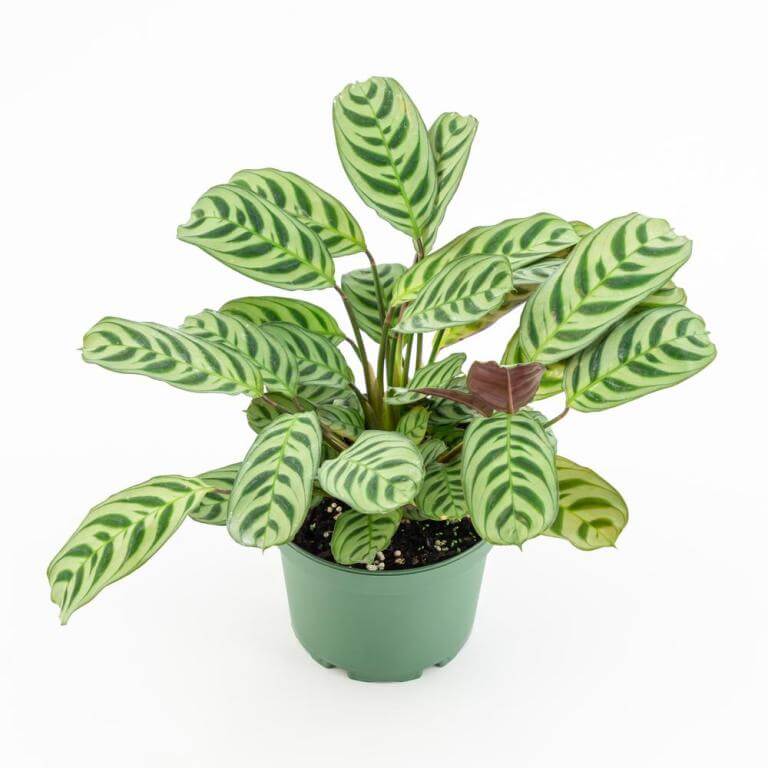
BUY NOW
Specifications
- Should not be placed in direct sunlight.
- Must be kept moist at all times.
- Should be kept in proper humidity.
- Ideal temperature should be 15-24°C.
- Good drainage is necessary.
- Re-potting every year is necessary.
- Recommended spacing is 24 inches.
- Once matured, the average height is 24 inches, the width is 18 inches.
- Has a dense growth habit.
Pros
- Perfect for indoors as it gives an appealing look.
- Not toxic to indoor pets like cats and dogs.
- Can fit in compact spaces.
- Can be considered as a gift plant.
- Does not attract insects.
- Not very difficult to take care of.
- Given the right care, it can survive for years.
- Does not require excess watering during normal climate.
Cons
- Needs the right temperature to grow well.
- Needs constant temperature as drops might affect its growth.
- Needs moist soil at all times.
- Too much fertilizer can result in brown spots on leaves.
FAQs
Q1. Will fluoride damage the plant in the water?
Yes, hence rainwater or distilled water without fluoride should be used.
Q2. What is the level of humidity required?
High humidity at 60 percent or more suits the peacock plant perfectly.
8. Variegated Obtusifolia Peperomia Plant
Well, if you’re looking for a gorgeous plant that fits perfectly in your house, then this is the right one for you. This plant has glossy rubber foliage, which gives out an elegant look. It grows very fast, so you will not have to wait long to see it mature.
Obtusifolia peperomia are natives of Southern North America and various South American countries. This bushy foliage plant has originated from areas of high humidity; hence taking care of that is a must. Light is an important aspect of playing a vital role in the growth of the plant. Therefore, finding the right spot of light indoors is necessary.
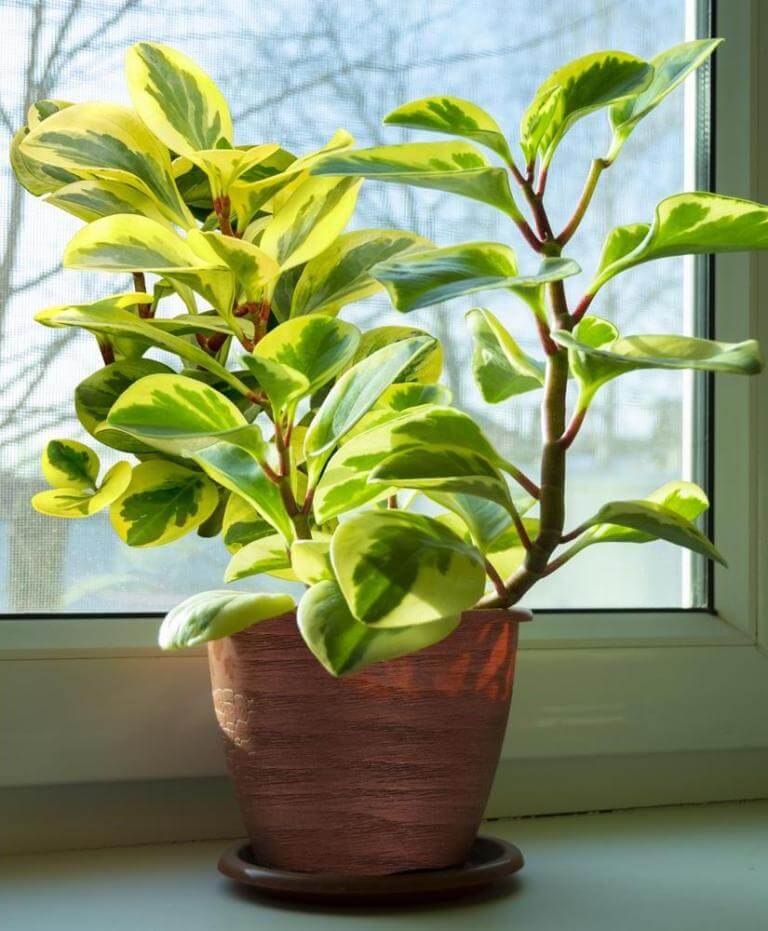
BUY NOW
Specifications
- Ideal temperature for best growth is 18-24°C.
- The plant will not survive in temperature below 10°C.
- Has colors of green and yellow beautifully mixed.
- Does not appreciate soil to be waterlogged.
- Think leaves store water, so ‘not enough water’ is never a concern.
- Well-drained soil is suited.
- Does not need repotting.
- Requires fertilizers every two weeks during spring.
- Best time to plant is during fall.
- Adopts trailing as a growing habit.
- Recommended spacing is 24 inches.
- Grows best in part sun.
- Average maturity Height- 48 inches. Width- 12 inches.
- Has no fragrance.
Pros
- Has a fast growth.
- Does not require to be repotted.
- Does not require much attention in context to watering.
- Can easily be grown outdoors.
- Non-toxic for cats and dogs.
- Smaller root system gives smaller trouble.
- Does not require high fertilization.
- Acts perfect as an indoor decoration.
Cons
- Requires proper humidity and part sun to grow, so taking care may be a problem.
- Is not very low maintenance.
- Might attract insects and pests.
FAQs
Q1. Why is the plant drooping?
It does not require too much water, but not watering it at all may result in it.
Q2. Is it okay to mist the plant?
Yes, being native to tropical climates, misting would not be a problem.
9. Tennessee Ostrich Fern
The Tennessee Ostrich Fern is one of the most beautiful ferns, deriving its name from the easily striking appearance of an ostrich tail from its leaves. These plants appreciate shade and moisture. The plants are of vibrant green color, but their colors fade if not given proper protection from heat and wind.
This plant does not only act as a decoration but is also edible and considered to be a delicacy in various parts of the world. The leaves of the plant are outwards towards its roots. The new leaves are called to be fiddleheads. They truly are a favorite food of the native Americans.
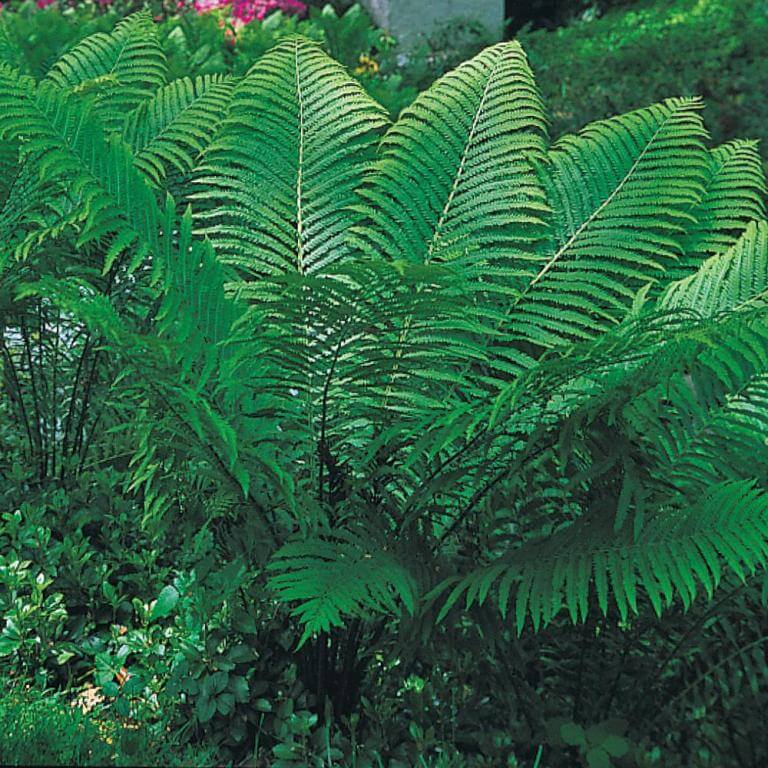
BUY NOW
Specifications
- Prefers partial or full shade.
- Prefers moist soil.
- Has a medium growth rate.
- Has featherlike serrated foliage.
- Is an aggressively spreading plant.
- Has a medium green color.
- The average mature height is 36 inches and width 24 inches.
- Has no fragrance.
- Adopts clumping growth habit.
Pros
- Is non toxic.
- Easy to grow.
- Tolerates average garden soil.
- Is completely edible.
- Easy maintenance.
- Gives out a pretty look where planted.
- Is deer resistant.
- Can be kept indoors.
- Has a reliable growth.
- Is resistant to most pests.
Cons
- The growth rate is not very fast.
- May attract insects.
- Loses color when exposed to direct sunlight.
FAQs
Q1. Are ostrich ferns evergreen?
No, the ferns are not evergreen.
Q2. What is the botanical name for it?
Athyrium Pycnocarpon is the botanical name for Tennessee Ostrich Fern.
10. Dwarf Egyptian Papyrus
The Egyptian Papyrus is also called the Prince tut because of its height. It is about half the height as that of King Tut but has poms at the end of the stems, equally as large. The specialty of this plant lies in its height. Its compact size makes it different and more lovable.
This beautiful plant with bright green foliage is sturdy. It is heat tolerant, and it has very fast growth. This plant can be kept in ponds, which would give the pond a touch of green beauty.
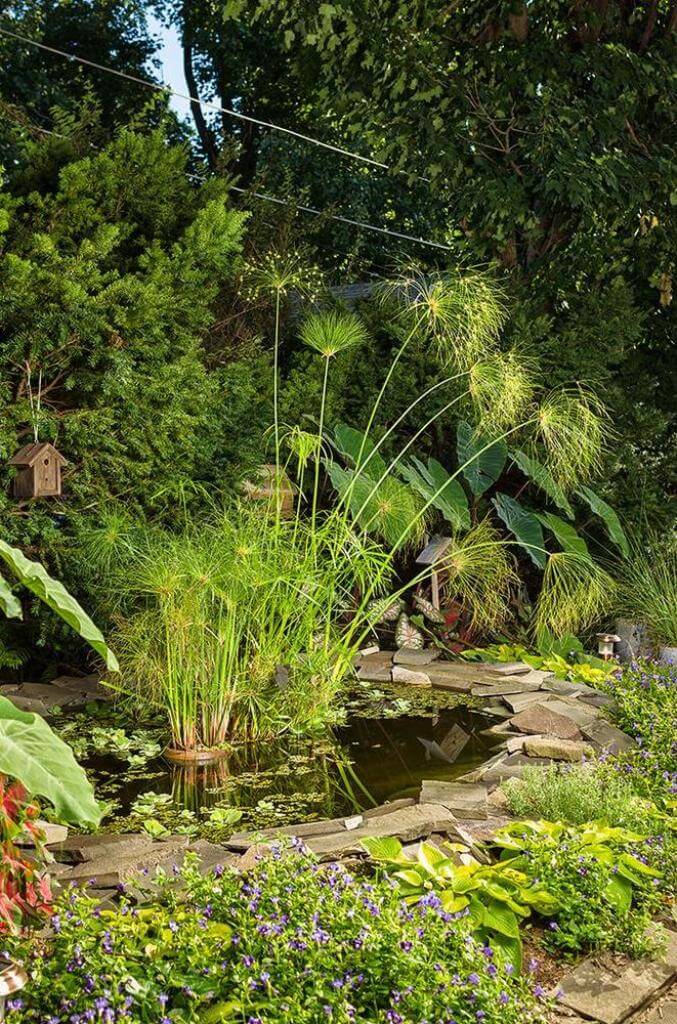
BUY NOW
Specifications
- Average height at maturity – 18 inches and width – 24 inches.
- Likes full sun or partial sun exposure.
- Minimum spacing should be 45-60cm.
- Has average maintenance.
- Requires high level of water.
- Can survive in chalk, clay, sandy soil.
- Has characteristics of being evergreen.
- Grows best in wet soil.
- Requires spacing of 18-24 inches.
Pros
- Has a bright color.
- Stands upright.
- Deadheading is not necessary.
- Not very difficult maintenance.
- Can be kept in ponds.
- Is heat-tolerant.
- Can survive unsuitable soil conditions.
- Compact in size.
- Disease and pests free.
- Grows very fast.
Cons
- Requires high level of water.
- Maintenance is not easy.
FAQs
Q1. Can the prince tut survive extreme winters?
No, the plant will die in extreme winters.
Q2. Are they hard to grow?
No, they are very easy to grow. In Fact, they grow very fast.
11. Autumn Fern
The Autumn Ferns are very commonly called the Japanese wood fern. Their botanical name is Dryopteris Erythrosora, and they give two beautiful colors. The reddish copper color shows up in spring, and the plant catches the eyes with its bright green color striking the eyes in the summer.
Like all other ferns, the autumn firm has no flowers or seeds in them. They are just plants with great foliage. They love a good shade and thrive well in moist soil, which is slightly acidic. This plant is very easy to take care of. Just water it when the soil feels dry, and you’re good to go!
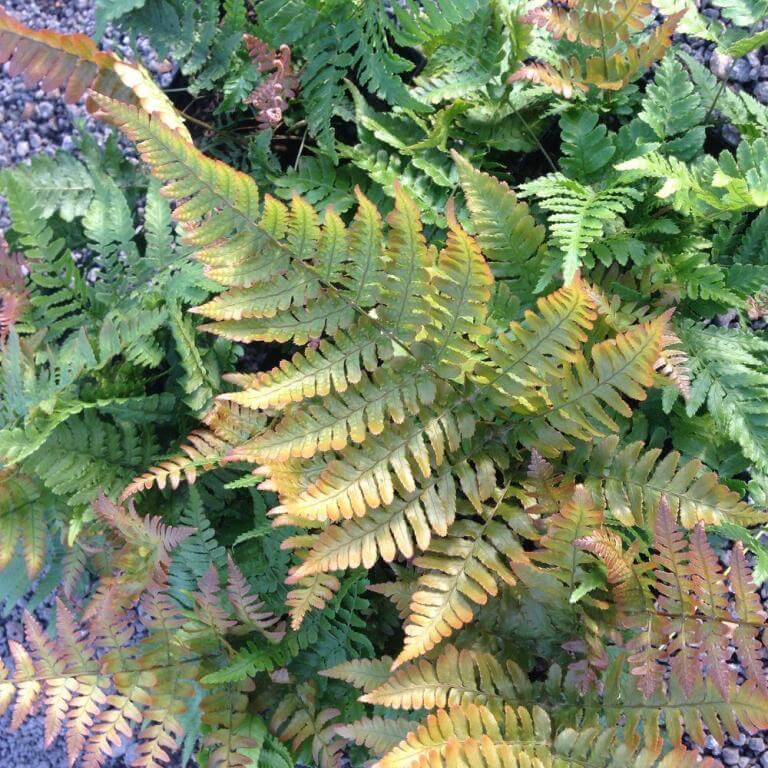
BUY NOW
Specifications
- Until established, it needs to be watered regularly.
- Grows best in well drained, moist soils.
- Should be fertilized every spring.
- Mature height is 24 inches Width 18 inches.
- Is non fragrant.
- Adopts clumping method of growth.
- Recommended spacing is 12-18 inches.
- It is copper while growing and bright green when established.
- Loves full shade or part shade.
Pros
- Once established, it is low maintenance.
- Has beautiful attractive colors.
- Can be kept indoors as it loves shade.
- No extra care is necessary as it has no flowers or seeds.
- Is insects-resistant.
- Deer resistant.
- Has a fast growth.
Cons
- Requires extra care in the initial stages.
- May rot in poorly drained soil.
- May be damaged by slugs.
FAQs
Q1. Is fertilization absolutely necessary?
No, fertilizers are not necessary but appreciate slow-release fertilizers.
Q2. When is the best time to plant?
The best time to plant is from spring to fall.
12. Quart Glacier Ivy
The Glacier ivy, also commonly called the English Ivy, is a houseplant. These plants are evergreen. They often trail across the gardens, and taking care of the Ivy is relatively easy. Moist soil and a consistent temperature will do the trick.
The Ivy is a native of the woodland areas. They love filtered light as it helps them become more colorful and prevents dryness from direct sunlight. After some point, all ivies turn red or purple.
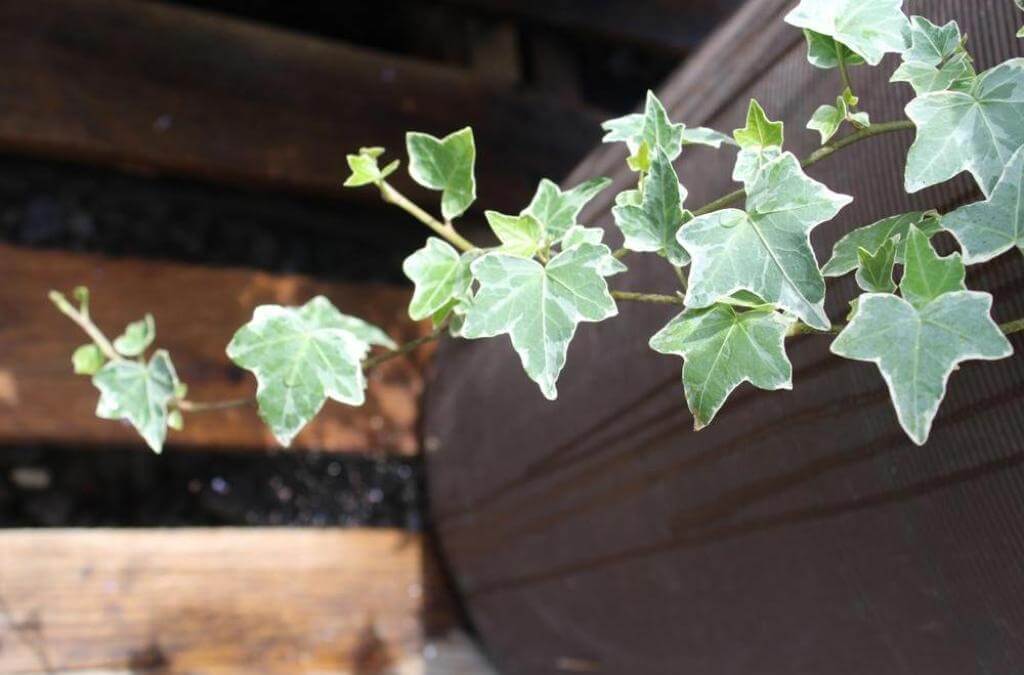
BUY NOW
Specification
- Prefer an evenly moist atmosphere.
- Love to be watered.
- Prefer filtered to low light.
- Spraying water weekly will help keep safe from insects.
- Using liquid fertilizer monthly is recommended.
- Constant care against pests and diseases.
- Botanical name is Hedra.
- Is non-fragrant.
- Mature Height 6 inches and Width 10 inches.
- Adopts vining as growth habit.
- Recommended spacing is 5 inches.
- Has beautiful green color, eventually changing to red/purple.
Pros
- Is Deer-resistant.
- Is perfect for indoors.
- Does not take up alot of space.
- Maintenance is not difficult.
- Can tolerate droughts.
- Does not require excess fertilizers.
Cons
- Attracts insects.
- May lead to skin allergies.
- Requires to be watered regularly.
FAQs
Q1. What is the botanical name for the plant?
The botanical name is Hedera.
Q2. Is the Ivy affected by temperature?
No, it is not, but constant fluctuations might affect the performance.
13. Creme Brulee Coral Bells
The Creme Brulee best grows in well-drained soils, and they love the part shade. The hybrids perform differently in different situations. Some do well in the sun, whilst some do well in the shade. They have rusty leaves and beautiful creme colors.
They have lobed rounded leaves, initially of orange color, eventually going to olive green color. They retain their colors for a long time and has no serious problem with insects or diseases.
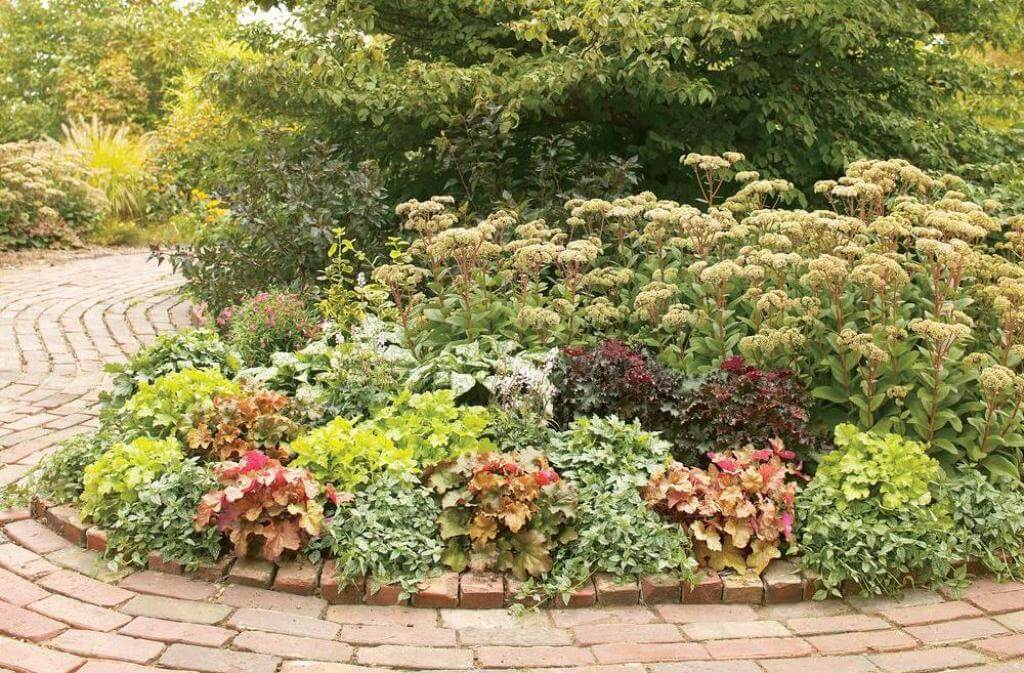
BUY NOW
Specifications
- Will survive in the sun or shade.
- Has a bright color.
- No serious problem with insects or diseases.
- Frost heaving of roots appear in fluctuating winters.
- Requires water twice a week.
- Recommended spacing is 16-24 inches.
- Mature height is 8 inches. Width is 12 inches.
- Adopts mounded growth habit.
- Has no fragrance.
- Commonly called coral bells.
- Best time to plant is during spring.
- Can survive in uneven soil conditions.
Pros
- Deer resistant.
- Not a serious insect attractor.
- Is drought-tolerant.
- Is Low—maintenance.
- Does not require constant watering.
- Can survive in the sun or shade both.
Cons
- Heavy temperature fluctuations may affect plants’ health.
- May have rust and bacterial leaf spot.
FAQs
Q1. Will the colors become dull in heavy sunlight?
No, the color usually stays.
Q2. Does it have a fragrance?
No, the plant is fragrance-free.
14. Southern Wood Fern
This plant is very commonly confused with southern shield fern having botanical name Dryopteris Ludoviciana. The southern wood fern is a gorgeous terrestrial fern of light green color. As a fern, it tolerates the sun better than other ferns.
The southern wood fern is also called Thelypteris Kunthii. It has beautiful arching leaves and is semi-evergreen to evergreen perennial. This elegant plant is perfect for enhancing the look of your garden when planted in groups.
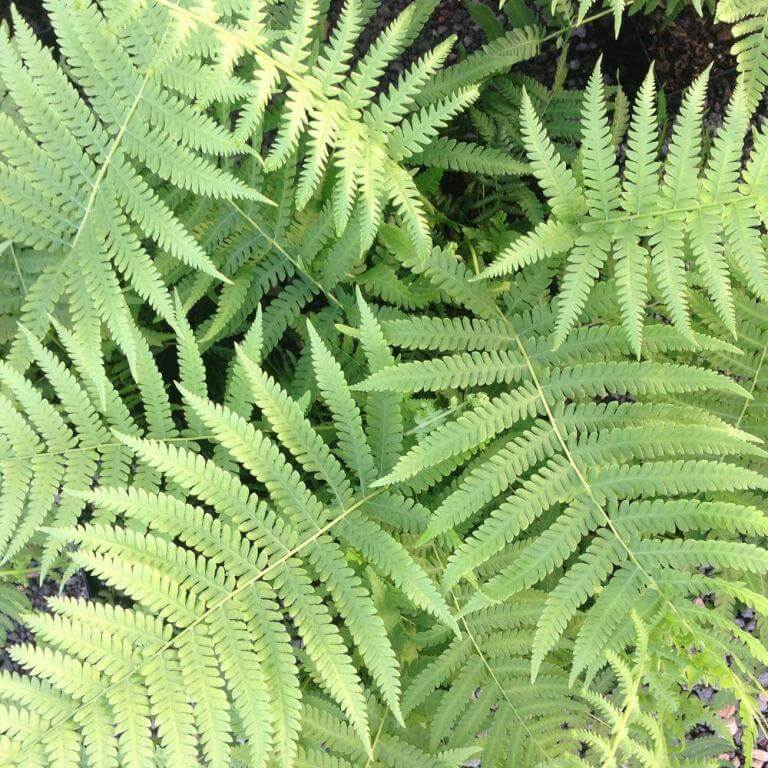
BUY NOW
Specifications
- Prefers rich, moist soil.
- Adopts clumping, arching, upright growth habit.
- The growth rate is moderate.
- Requires full shade or part shade.
- Does not require difficult maintenance.
- Attracts visual attention.
- Resists harmful things.
- Mature height is 24 inches with a width of 30 inches.
- Best time to plant is from spring to fall.
- Does not have fragrance.
- Recommended spacing between plants is 24 inches.
- Requires water twice a week.
Pros
- Stands upright with beautiful arching leaves.
- Requires low maintenance.
- Resistant to insects and pests.
- Resistant to deer and rabbit.
- Can survive in drought.
- Tolerates heat and humidity.
- Does not require daily watering.
- Can survive up to 9 months in dry conditions.
Cons
- If kept in drought for too long, the plant may die.
- Prefers shade more so can’t always be kept in heavy sun.
- Requires moist soil at all times for best growth.
FAQs
Q1. How tall can the plant get?
The plant can grow up to 3ft tall.
Q2. Does this plant give out any fragrance?
No, this plant does not give out any fragrance.
Q3. How many plants are available in a 2.5 qt pot?
One plant comes in a 2.5 qt pot.
15. Diamond Grass
The botanical name for Diamond grass is Calamagrostis Brachytricha. It is also called Korean feather grass. The plant has ornamental value and stands upright with beautiful arches. The leaves are glossy green. Beautiful pink plumes grow, which can reach up to 4 feet high.
This easy to grow grass requires medium to wet soils. They prefer partial shade but can do well in full sun with the help of moisture. Its differentiating quality is that it can do well in heavy clay soil. This makes them the most ornamental grass for North Carolina.
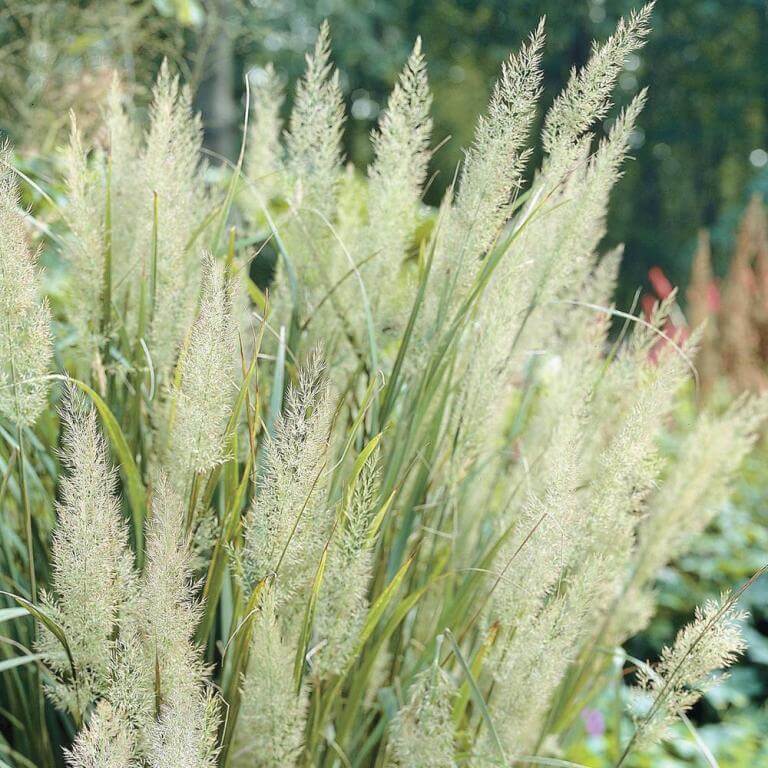
BUY NOW
Specifications
- Mature height is 48 inches with a width of 40 inches.
- Best time to plant is from spring to fall.
- Commonly called Feathergrass.
- Does not have a fragrance.
- Adopts clumping method of growth.
- Recommended spacing is 40 inches.
- Prefers partial shade.
- Does not require stressful maintenance.
- Requires moist soil.
- Does not attract insects and pests.
- Does not cause pollution.
- The length of leaves, on average, is 3-6 inches.
- Catches the eye with its appealing look.
Pros
- Resists deer and rabbits.
- Resists insects.
- Attracts beautiful songbirds.
- Can survive wet soils.
- Can survive the full sun.
- Has pretty glossy foliage.
- Is the most ornamental.
- Has easy maintenance.
- Can survive in heavy clay soils.
Cons
- Cannot last long in droughts.
- Might have hampered growth in heavy sun.
- The growth rate is not quick.
FAQs
Q1. Will it die completely in full sun?
No, it can tolerate full sun but might not grow properly.
Q2. Does it resist salts?
Yes, it is resistant to salts.
16. Blue Mohawk
The Blue Mohawk, also called the Juncus, is a warm-season grass. It has beautiful unordinary foliage of bluish-green color. Since it is a warm-season grass, growth until late spring is not possible. During winter, it changes color and turns to shades of brown.
It is an ornamental grass that prefers soil with moisture and stands upright. It loves shady areas and is commonly called a soft rush.
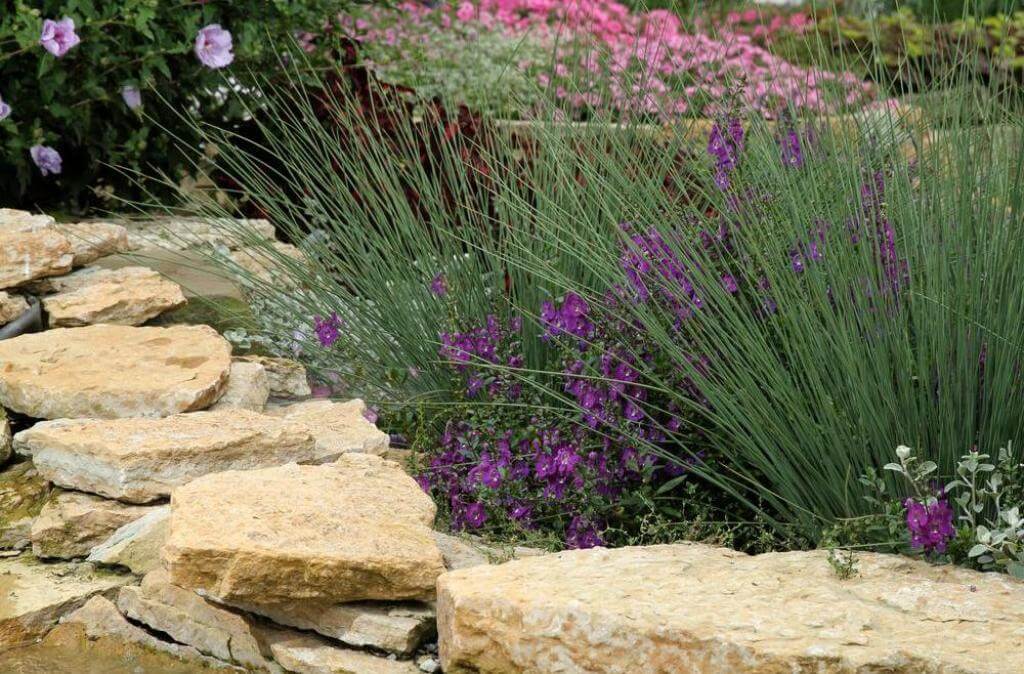
BUY NOW
Specifications
- Requires full shade.
- Mature height is 24 inches with a width of 8 inches.
- Best time to plant is during spring.
- Does not have a fragrance.
- Adopts an upright growth habit.
- Recommended spacing is 8-12 inches.
- Requires water twice a week.
- Does not require hectic care.
- Had a colorful foliage.
Pros
- Is low maintenance.
- Can survive in dry soil.
- Can be used as a water plant.
- Adds an eye-catching touch to plain areas.
- Can be used for erosion control.
- No serious problem with insects and diseases.
- Tolerates heavy soil.
- Can self seed easily.
Cons
- May not survive droughts.
- Does not do well in excess direct heat.
- May come in contact with insects.
FAQs
Q1. Will the plant grow back after turning brown?
Yes, since it is a warm-season plant, it turns brown in winter, but it will grow back.
Q2. Will it grow in a pond?
Yes, it will grow in the pond.
17. Holly Fern
The name is kept behind its resemblance of holly-like leaves. Its foliage is sharp-tipped dark green colored, which creates a perfect contrast to a flowerbed. It is also called the Japanese holly fern.
Surviving cold to an extreme level might not be possible, but a little harsh winter season can be tolerated. This plant is evergreen in tolerable climates. Holly fern loves a good shade but will not complain in partial sunlight. Although complete direct sunlight will hamper its growth.
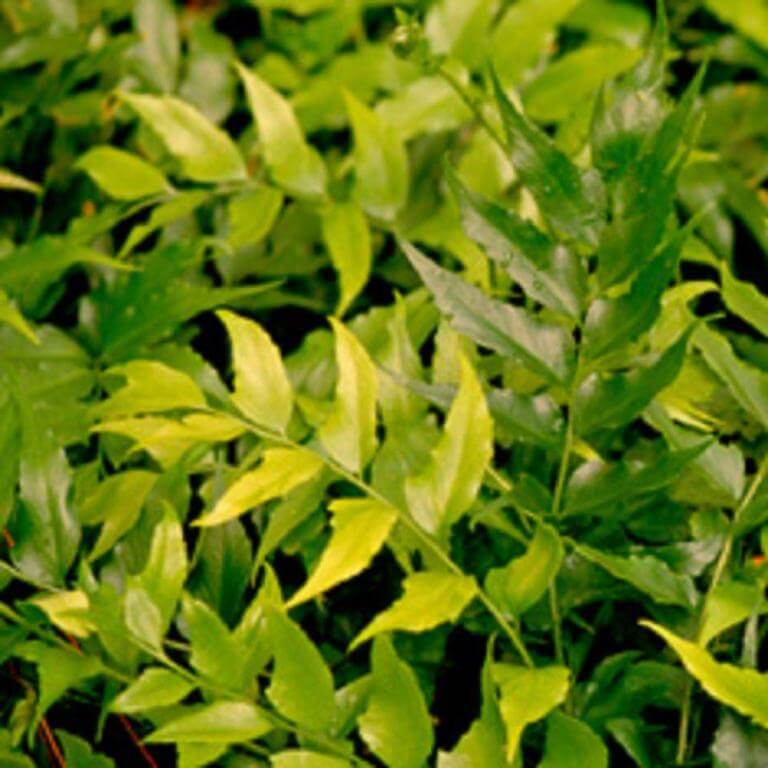
BUY NOW
Specifications
- Is a houseplant.
- Not suitable for extreme climates.
- Prefers well-drained soil.
- Grows best in full shade.
- Requires weekly watering.
- Is not difficult to take care of.
- Appreciates slow release fertilizers.
- Is a light feeder.
- Has a beautiful dark green foliage.
- Mature height is 24 inches, and the width is 36 inches.
- Best time to plant is from spring to fall.
- Does not have a fragrance.
- Adopts spreading growth habit.
- Recommended spacing is 18-36 inches.
Pros
- Has foliage of beautiful color and texture.
- Can be kept indoors.
- Is low maintenance.
- Is deer-resistant.
- Does not attract insects or pests.
- Can survive mild fluctuations in climate.
- Does not have a slow growth.
- Can survive in dry soil for some time.
Cons
- Cannot survive the extreme climate.
- May not last long in drought.
- Needs to be watered.
FAQs
Q1. How often should the plant be watered?
The plant should be watered every week.
Q2. Is it well suited for shade or sun?
It requires full shade for best growth.
18. Blue Fescue Grass
The name comes from their vibrant blue colored wiry blades. This grass is evergreen and can tolerate various conditions easily. It creates no pollution and can be perfectly maintained.
They love sunny locations where their blue colors come out brighter.
Although extreme heat can affect the life of the plant a lot, the roots of these plants are not deep. The plants may not survive soils that are too heavy.
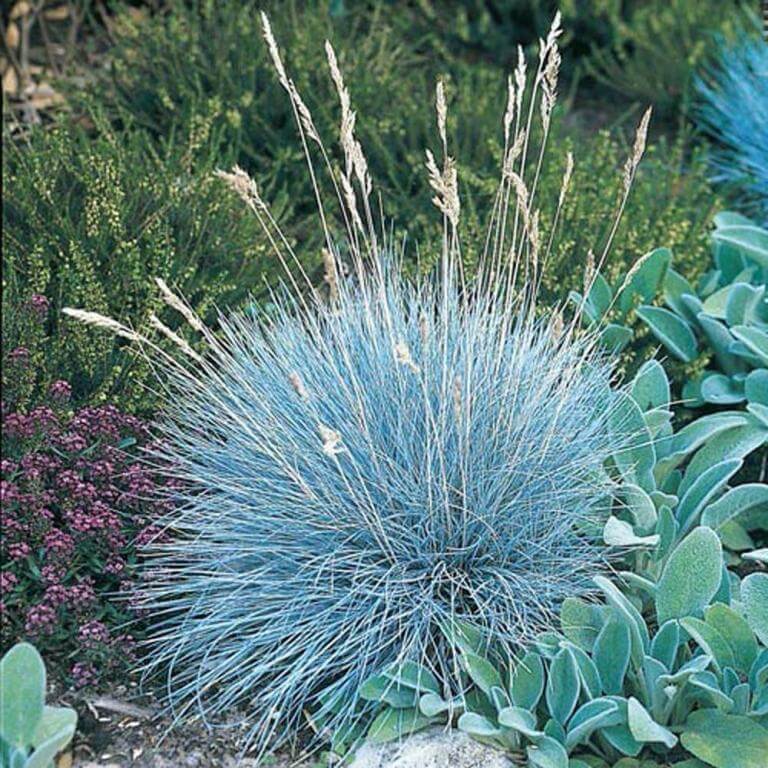
BUY NOW
Specifications
- These plants do not require excess fertilization.
- Has attractive colored foliage.
- Requires average moisture.
- Requires constant water in summer.
- Requires moist soil.
- Does not require tough maintenance.
- Grows best in the sun.
- Mature height is 12 inches, and the width is 8 inches.
- Best time to plant is from spring to summer.
- Commonly called fountain grass.
- Adopts clumping method.
- Requires water twice a week.
Pros
- Is very low maintenance.
- Keeps the surroundings clean.
- Does not attract insects.
- Is protected from pests.
- Enhances the beauty of the outdoors.
- Has pretty foliage.
- Is deer-resistant.
- Does not need to be fertilized often.
Cons
- Cannot survive in heavy clay soils.
- Cannot survive in extreme direct heat.
FAQs
Q1. What is the botanical name for the plant?
The botanical name for Blue Fescue is Festuca Glauca.
Q2. Does it have a fragrance?
No, this plant is fragrance-free.
19. Purple Love Grass
How can someone not want the plant which has ‘Love’ in its name? This grass is also called Eragrostis Spectabilis. It is a warm-season grass with beautiful colors such as purple foliage and blue-green blades. This plant also has an amazing texture.
Purple love grass thrives best when it is out in the sun. It is drought tolerant and hence can do well even in dry soil. They have fibrous roots, and blade-like leaves can go up to 10″ long. The leaves form a beautiful arc and cover itself in a reddish hue during the autumns.
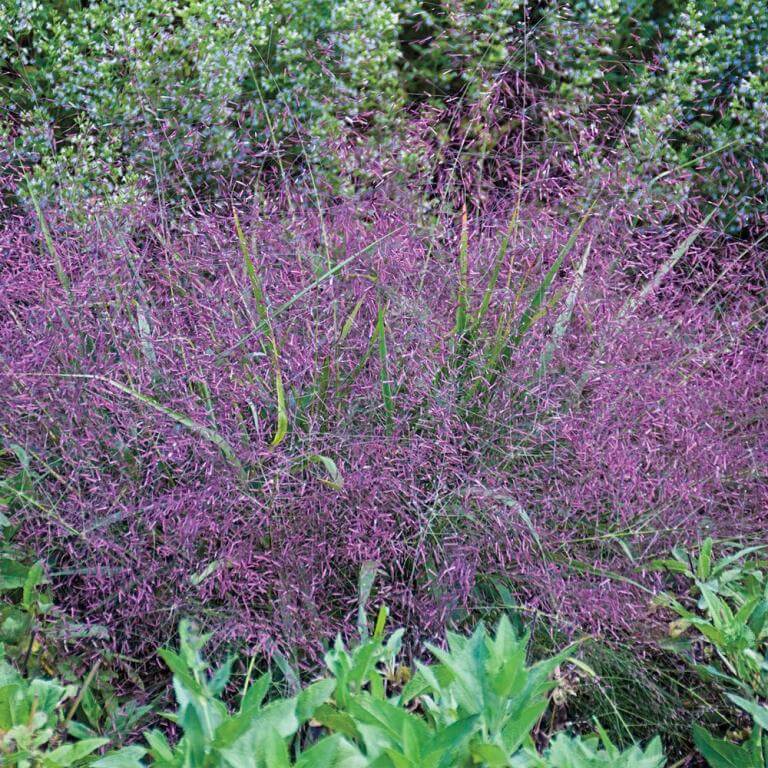
BUY NOW
Specifications
- Grows best in full sun.
- Likes dry and infertile soil.
- Tolerates droughts.
- Are short-lived.
- Has heavy foot traffic.
- Is a warm-season grass.
- Growth rate is fast.
- Mature height is 24 inches, and the width is 18 inches.
- Does not have a fragrance.
- Has a clumping growth habit.
- Recommended spacing is 20 inches.
- Requires water twice a week.
Pros
- Easy to maintain.
- Deer and rabbit resistant.
- Does not attract insects.
- Pests resistant.
- Grows fast.
- Can survive in droughts.
- Is salt-tolerant.
- Had beautiful bright colors.
Cons
- Very short-lived.
- Excess water may hamper growth.
- Blades may dry over a short span.
FAQs
Q1. Will the plant prosper in gravelly soil?
Yes, the plant loves dry, sandy, or gravelly soils.
Q2. Which is the best companion?
Purple love grass would love the company of Aster Divaricatus.
20. Colossal Blue Hosta
This plant is of an attractive blue-green color with heart-shaped leaves that make these plants stand out amongst others. To add to their beauty, they have lavender-colored flowers pop up during the summer season.
Its blue color depicts various emotions and changes the look of the place as a whole. Its foliage stays the same if kept in the shade, or it might lose its charm out in the sun. This plant prefers moist soil and loves to eat, so fertilizers come in handy.
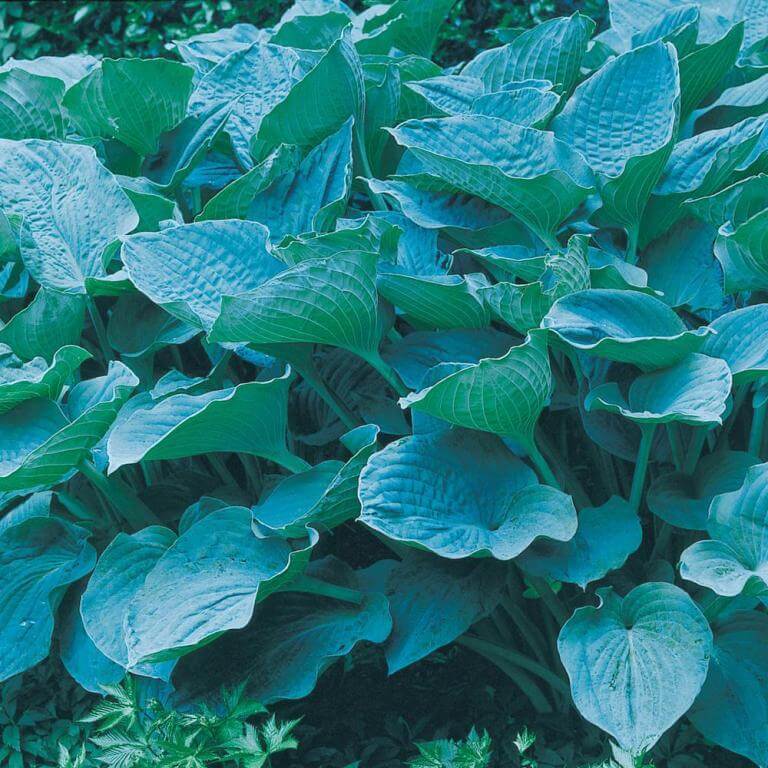
BUY NOW
Specifications
- Prefers moist soil.
- Color fades away in heavy sunlight.
- Is a heavy feeder.
- Foliage is heart-shaped.
- Blooms during midsummer.
- Will prosper in well-drained soil as well.
- Is resistant to slugs.
- Requires full shade or part shade to grow best.
- Is not hard to maintain.
- Mature height and width are 36 inches and 48 inches, respectively.
- Best time to plant is from spring to fall.
- Does not have fragrance.
- Adopts clumping growth habit.
- Recommended spacing is 48 inches.
- Requires water twice a week.
- Does not attract wildlife.
Pros
- Is low maintenance.
- Retains the color for long time.
- Can be kept indoors.
- Survives in moist or dry soil both.
- Attracts pollinators.
- Resistant to slugs.
- Resistant to deers.
- Looks make up for the missing fragrance.
- Growth is fast.
Cons
- Requires fertilizers very often.
- May attract insects which prove harmful.
- Loses color if kept in the sun.
FAQs
Q1. What is the botanical name of the plant?
The botanical name of the plant is Hosta Sieboldiana Elegans.
Q2. Are the leaves arched?
No, the leaves are not arched but do have an attractive heart shape.
CONCLUSION
It can often become challenging to choose something that you would make a part of your life, no matter how small it is. As for plants, they make a great companion for us, and others like them. They not only make our gardens and households look much prettier but also add a positive aura to the place with their mere existence.
We have listed all the details of each plant, including their pros and cons, so that you can easily choose the best one. All you have to do is know your requirements and bring a beautiful partner home! So what’s the wait? Make your lives soothing with these wonderful life forms today!





